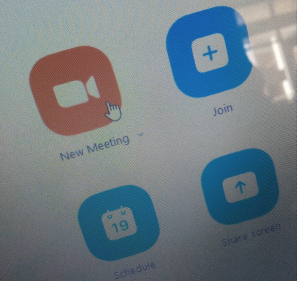As the United States enters its third year of grappling with the COVID-19 pandemic, students and employees across the nation have been plagued by a digital affliction of the mind: Zoom fatigue.
A literature review conducted by Dr. Jeremy N. Bailenson of Stanford University in 2021, and published in the journal “Technology, Mind, and Behavior,” has put forth four arguments as to why Zoom fatigue is so prevalent and so debilitating.
First, Zoom users must withstand close-up eye gaze for several hours on end, which is taxing on the psyche due to the intimate nature, typically reserved for close friends and family. Faces also appear closer to the user than they would in the real world due to the distance at which most users keep their cameras from their faces.
Second is the cognitive load required to interact with others in Zoom-space. Users receive fewer cues over a video call than they would in person, the result being a strain on users to glean as much information as possible from the limited input of a video call, especially if users are rushing between digital and in-person meetings.
Dr. Jessica Hamm, a professor of mathematics at Winthrop, says “I am used to interacting with students, and with Zoom I typically feel as though I am giving so much energy and getting nothing back. It takes away my favorite part of the job, which is connecting with students.”
However, she does report some benefits: “It is so much more convenient to be able to join a meeting virtually, especially as a parent of two kids!”
“It was a bit overwhelming to go to an in-person and then rush back to my dorm to hop onto a Zoom meeting and then back to an in-person class,” says Michelle Aguilar-Gaspar, a sophomore biology major. “It didn’t even really feel like I was going to college.”
Third, the self-view video feed of the user’s own camera can make users feel increased levels of self-consciousness. A study being published in March by Kristine M. Kuhn of Washington State University in the journal “Computers in Human Behavior” found that individuals with a high public self-consciousness felt more negatively towards video calls the more often their face was visible.
“Constantly being on a screen and having to self-monitor my actions felt terrible,” says Rollins Mosely, a sophomore musical theater major. “It limited the time I spent outdoors and with friends. My stress levels definitely went up.”
Fourth, video calls entail reduced mobility. Workers and students who have previously been afforded some mobility through walking around the workplace or moving from class to class have now been stuck behind their screens in the same spot for as long as their meetings or classes last.
“I did not have the opportunity to develop a professional relationship with my teachers or my peers,” says Olivia Cantrell, a senior mathematics major. “I was constantly distracted by things at home due to the rest of my family being home as well.”
Josiah Bauer, a recently graduated mathematics major, has voiced his concerns about the lack of movement caused by the need to video call. “I needed to find a place with a stable internet, which can be rare on campus, and then stay in that spot for however many classes I had in a row. I felt stuck.”
Zoom fatigue also appears to affect women more than men. In a different study published by Stanford researchers in 2021, it was found that women reported feeling the effects of Zoom fatigue upwards of 13.8% more than men, even when controlling for difference in duration and time between meetings.




